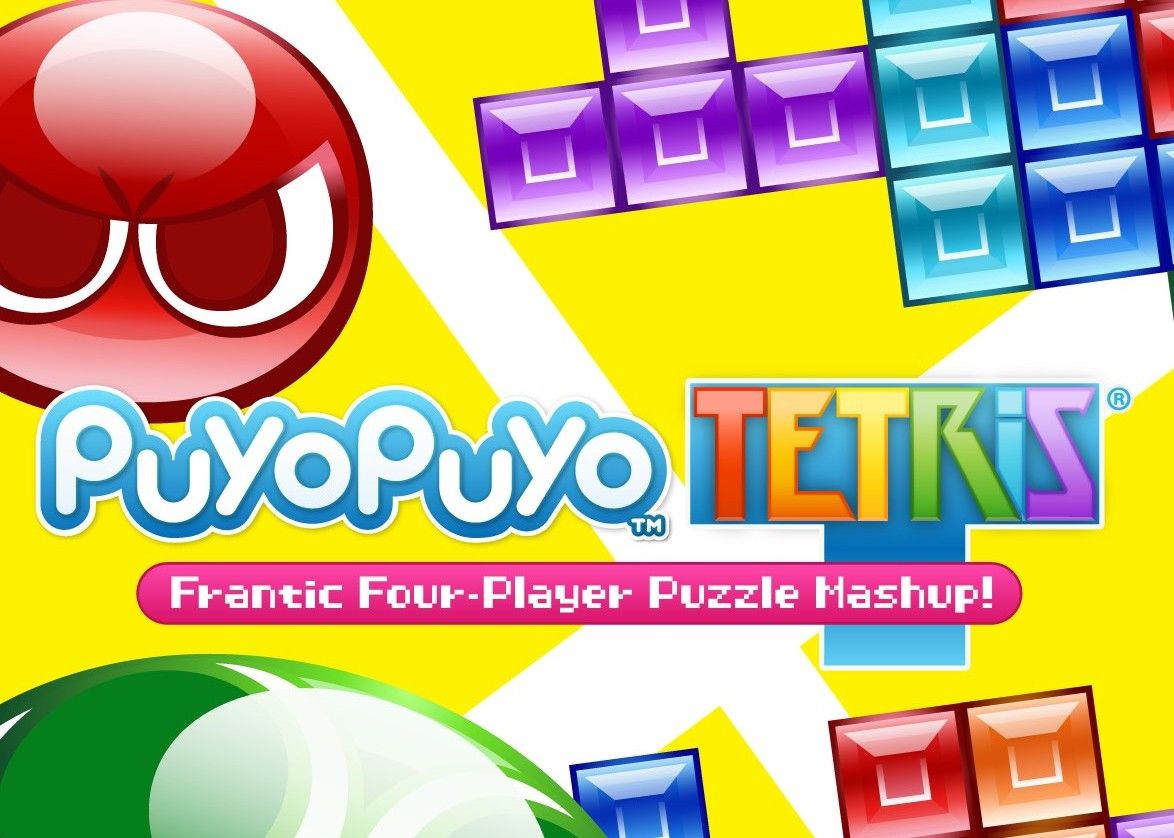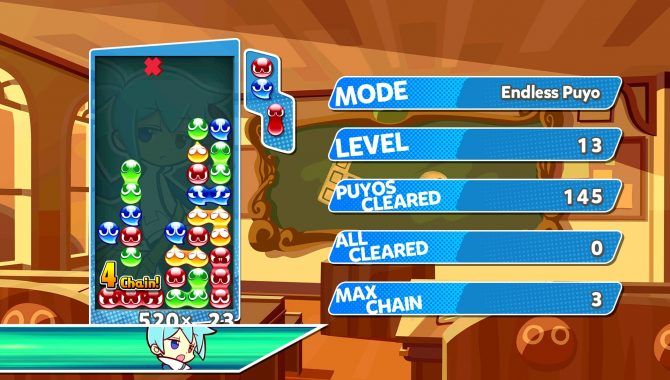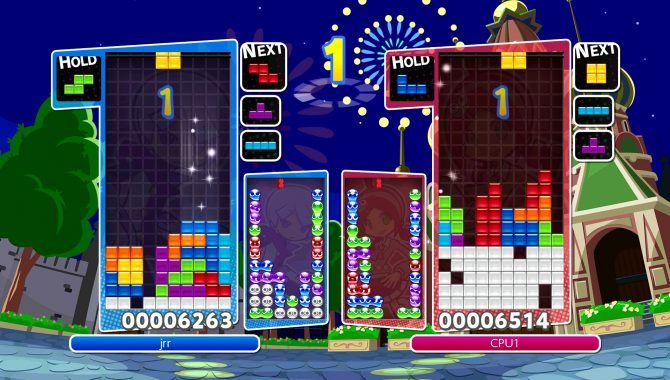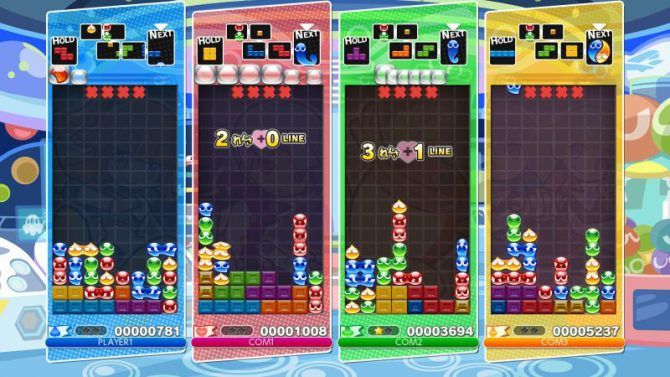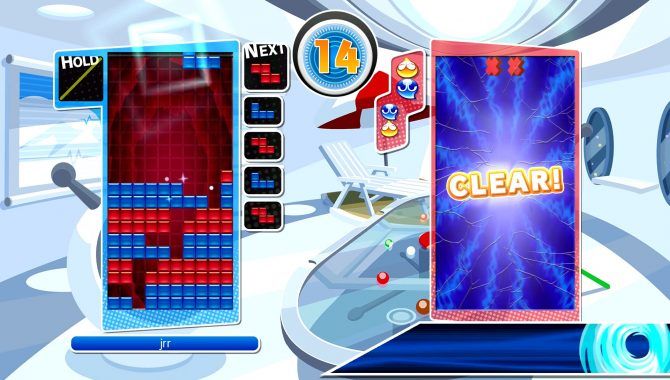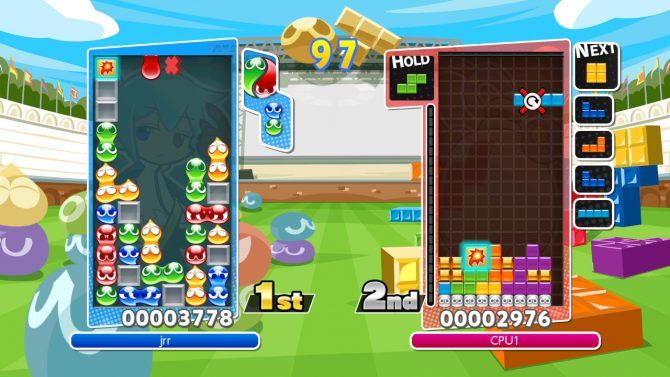I love Tetris! While I had played it casually at various times growing up, a couple of years ago a friend introduced me to the deeper mechanics of the game and got me hooked. While I am nowhere near Grandmaster levels of talent at Tetris, I still consider myself pretty good, so I was thrilled to see this addictive puzzle game being featured in another console title: Puyo Puyo Tetris.
The first two words of the title, Puyo Puyo, were fairly unfamiliar to me though. This is because that puzzle game series, which has players gathering the titular Puyo in like-colored groups in order to score points, saw its last localized release in North America with Puyo Pop Fever on the Nintendo DS back in 2004.
Even before then, Puyo Puyo games were reskinned in the west to feature more popular characters in games such as Kirby's Avalanche and Dr. Robotnik's Mean Bean Machine, so the series never caught on in North America, and I certainly never had much access to it.
Tetris and Puyo Puyo are fairly similar in a few areas though, so I was curious to see how this crossover came out. Puyo Puyo Tetris met my expectations, delivering engaging and thoughtful gaming that will hopefully grab others, just like it has taken hold of me.
To understand the game's modes, you'll need to know the basics of both Puyo Puyo and Tetris. In Puyo Puyo the titular creatures fall from the top of the screen, and can be an combination of red, blue green, yellow, and purple. Puyos of the same color must be placed in groups of four in any way except diagonal in order to be wiped from the screen and garner players points. If the creatures stack too high and hit an X on the top of the board, it’s game over.
[pullquote]As someone who had never experienced Puyo Puyo before, I can say that I did find its color-matching gameplay quite fun, even if it moved a tad slower than its counterpart in this game, Tetris[/pullquote]
Players can turn around and move the Puyo as they fall, and can even quick drop them to speed up the process. Puyo's popped in succession can rack up massive combo points that can also prove useful in multiplayer matches as they can send large amounts of garbage to opponents. If one gets garbage on their board, it can be wiped away by popping Puyo's next to it.
You can see which Puyo's are coming up, so it is very beneficial to plan ahead so you can rack up chains and combos. As someone who had never experienced Puyo Puyo before, I can say that I did find its color-matching gameplay quite fun, even if it moved a tad slower than its counterpart in this game, Tetris.
For everyone who has never played a video game before, the main goal of Tetris is to fit different shaped Tetriminos (sic.) together with full lines of them, consequently making rows disappear and rack up points. Players can either do a soft drop, descending the piece slowly, or a hard drop, which puts the Tetrimino wherever the "ghost piece" underneath it is. Players can also hold a single Tetrimino for later use, which can come in handy in multiple situations.
[pullquote]The game is easy to learn, but hard to master, and will keep players enthralled in Puyo Puyo Tetris, just like it has for years.[/pullquote]
There are also more advanced mechanics like combos, which can be constructing by clearing multiple lines in a row, and t-spins, which happen when a t-shaped Tetrimino piece is fitted into an hard to fit area, giving whoever pulls it off extra points. All garbage pieces that drop have open spaces in them, and can be cleared by completing the row they are on. The player gets a game over if the blocks reach the top.
The controls can be a little weird at first; the hard drop function is mapped to “up” so the D-pad becomes the only feasible option to control it, otherwise you may accidentally hard drop with the controls spins. I also found t-spins to be harder to execute with these controls. Luckily, I got used to the game's control scheme and Tetris is still just as fun to play now as it was when it was first created by Alexey Pajitnov all the way back in 1984. The game is easy to learn but hard to master, and will keep players enthralled in Puyo Puyo Tetris for years to come.
These two well-respected puzzle game series combine in Fusion, one of the game's exclusive Arcade modes. As the title suggests, Fusion splices the two gameplay styles together into something that is both familiar and unique. Both Puyos and Tetrominoes fall from the top, and can come in any order. The clearing rules for both still apply, so you have to be careful to not get too many Puyos clogging up your Tetromino lines, or blocking Puyos with Tetriminos.
[pullquote]Fusion mode definitely spices up what seems to be the typical Puyo Puyo series formula.[/pullquote]
If a Tetrimino lands on a group of Puyos, it temporarily destroys them; after a brief period of time, those same squishy creatures fall from the top of the screen. This can be dangerous, as they can quickly stack to hit one of the predetermined game over spots, Puyo Puyo style. You can hold both the Tetriminos and the Puyos for situations that they might be useful for, like Tetris, so Fusion mode definitely spices up what seems to be the typical Puyo Puyo series formula.
There is one brand new piece exclusive to Puyo Puyo Tetris: the Special Tsumo. This piece constantly shifts between being a Puyo and a Tetrimino, meaning it can become a Tetris piece that is more domino-shaped, or a Puyo that is much larger than usual. This new piece definitely threw me for a loop when it first showed up, and will most likely do so for other fans of both series as well.
My only small gripe with this mode is that Puyo Puyo and Tetris inherently move at different speeds, so switching between the two on the same board can be jarring, especially in tricky situations. Fortunately, you can learn the game well enough to avoid those situations in the immensely detailed but entertaining tutorial.
There are tutorials for both basic Puyo Puyo and Tetris too, meaning that newcomers to both series won't feel out of place. This is where I obtained most of my Puyo Puyo knowledge, and it now has me interested in the rest of the series.
The Arcade portion of the menu also includes other modes. The first mode is Versus, which is a typical versus mode where players can face off against either their friends or the CPU in a Puyo Puyo or Tetris match. Party mode introduces special power-ups in the mix that include obstructing you or your opponent’s view, or increasing the speed your pieces fall at. Party mode was more frustrating than enjoyable, and quickly became my least favorite mode of the package.
[pullquote]By keeping both game's styles separate, but still requiring you to use both in order to be successful, the developers crafted one of the most fun puzzle game modes in recent memory. [/pullquote]
Next comes Swap, which I found to be the most rewarding mode that focused on the crossover. At the start of each Swap match, a roulette decides whether or not the match starts on a Puyo Puyo or Tetris match, which will then switch to the other a set interval. The match ends if you or your opponent loses on either on either of the boards as they switch back and forth. By keeping both game's styles separate, but still requiring you to use both in order to be successful, the developers crafted one of the most fun puzzle game modes in recent memory.
Big Bang has players face off and try to clear as many preset Tetrimino and Puyo patterns as fast as they can. After a certain amount of time, the scores are tallied, and ones with the lower score are damaged. The match goes on until one of them is knocked out. I found this mode to be exhilarating, and it is even more a blast online or in local multiplayer.
Finally, there is Challenge mode, which includes six smaller challenges. This includes Endless Fever, where players must clear as many Puyo Puyo or Tetris lines as fast as possible within the time limit; Endless Puyo, which is self-explanatory; Tiny Puyo, where the Puyos are much smaller than usual and specialty larger ones are introduced; Sprint, where you try to clear 40 lines in Tetris as fast as possible; Marathon, where you try to clear 150 lines in Tetris with the highest score possible; and finally Ultra, where you try to rack up the highest score possible in Tetris in three minutes.
Outside of the game's Arcade modes, the Adventure mode also serves as a fun introduction to the game and all of its modes for new players. It features a largely nonsensical, albeit charming and fully voice-acted, story featuring characters found in previous Puyo Puyo titles.
These junior-high students, led by Ringo, are caught off guard by the sudden appearance of Tetriminos in their world, and are soon whisked away to meet Tee, Captain of the Starship Tetra and the King of Tetris. After meeting each other, they must team up to stop the worlds of Puyo Puyo and Tetris from merging.
[pullquote]I found most of the dialogue witty and self-referential, like when it is humorously pointed out how characters are so trusting in each other after just one battle against each other.[/pullquote]
The story itself is nothing great, but the game seems to recognize this and goes all the way with what it has. I found most of the dialogue witty and self-referential, like when it is humorously pointed out how characters are so trusting in each other after just one battle against each other, or how the characters are still willing to face each other in Puyo Puyo matches, even if it usually teleports them somewhere crazy. The dialogue is fully voiced acted in English and, while most of it is good, some of the characters sound bland and uninterested.
Stages in Adventure mode cover all of the game's modes, and each level has its own three-star rating system, rewarding players who are more skilled. While Adventure mode may not be much more than a fun distraction to help players get more assimilated to the game, its funny dialogue and decent voice acting kept me interested.
All of the Arcade modes can be played in either local multiplayer or online. Playing locally in Tetris is just as fun as it has always been, and this functionality also makes it easier to introduce Puyo Puyo to new people. I also had a very smooth online experience, experiencing little to no lag at all. The game has been available in other regions for a while though, so expect some more skilled players to be showing off their prowess online.
There is also a special shop players can visit to by alternate skins for the puyos and tetrominos, new music, sound effects, and voices for the characters. The Tetris theme is back in all its glory, as are the classic sound effects, so the game is enjoyable to listen to.
The most grating thing about the game can be the voices. During matches, characters will shout random nonsense when they do things like clearing multiple lines in a row. While this is cute at first, hearing Ringo shout the same thing over and over again get real annoying the hundredth time you hear it.
While I still think Tetris is the better game in this match-up, and that it has a slight in-game advantage due to its faster speed, and that the voice acting can get grating after awhile, I loved my time with Puyo Puyo Tetris. It familiarized me with a puzzle game franchise and group of characters that I had never heard up before while also delivering a solid console Tetris experience, which makes it steeper price acceptable. I hope SEGA continues to bring over more Puyo Puyo games to the west, as it has the possibility of catching on just like Tetris did years ago on the Game Boy.

